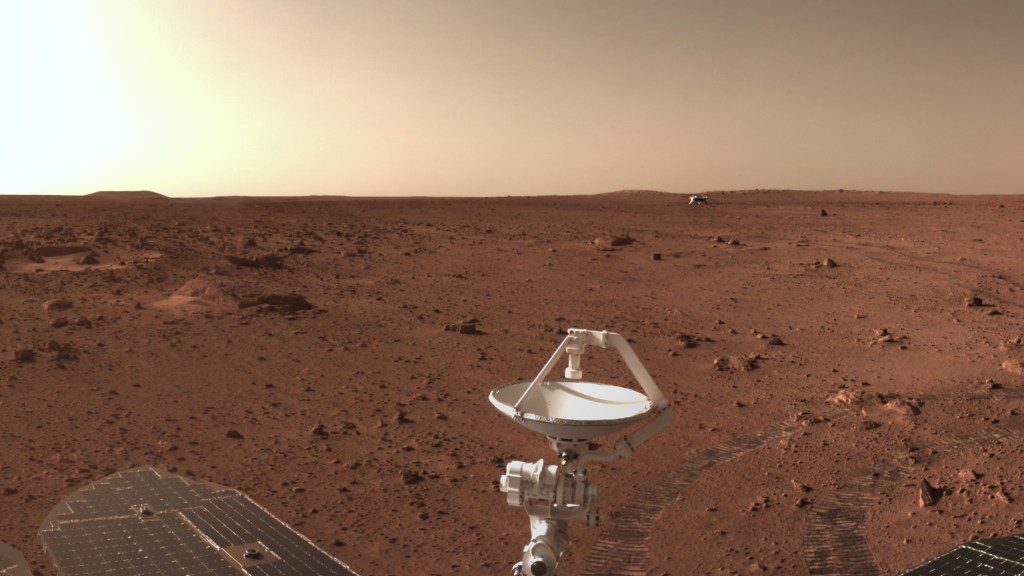China is moving forward with plans to launch its Tianwen-3 Mars sample return mission by 2030 and has identified possible landing locations.
The work on China's Tianwen-3 Mars sample return mission is progressing smoothly and is expected to launch around 2030, according to Sun Zezhou, a senior engineer at the China Academy of Space Technology (CAST). told On March 6, Sun, who was the chief designer of China's successful Tianwen-1 Mars orbiter, shared updates on the mission with China Central Television (CCTV). rover mission.
The update, although brief and unclear, is significant as NASA faces challenges with its Mars Sample Return (MSR) mission due to budget and schedule concerns. reassessing NASA has postponed a decision on spending for MSR, possibly impacting the mission's schedule and funding due to budget and schedule concerns. Budget and schedule concerns have led NASA to delay decisions on spending for its Mars Sample Return (MSR) mission.A final fiscal year 2024 spending bill has put off a decision on spending for MSR. A final fiscal year 2024 spending bill has deferred a decision on spending for MSR. The final fiscal year 2024 spending bill has deferred a decision on spending for MSR.
China's approach to the Tianwen-3 Mars sample return architecture is simpler than NASA's, yet still a very complex mission. Two Long March 5 launches are expected to carry a lander, ascent vehicle, orbiter, and return module. Entry, descent, and landing will draw on technology used for the Tianwen-1 rover landing.
The lander will employ a robotic arm to collect surface samples and a drill to obtain material from up to two meters below the surface. Additionally, either a six-legged crawling robot or a helicopter similar to Ingenuity may be included in the mission to collect a diverse set of samples. The mission aims to deliver around 500 grams of Martian samples to Earth. Sun described the main challenges as collecting rock samples, taking off from the Martian surface, rendezvousing and docking in orbit, and transferring samples to a reentry module. These tasks require a high level of autonomy in terms of system design. Sun emphasized that the technical foundation is already in place, citing China's experience with Mars entry, descent, and landing from the Tianwen-1 mission, as well as the sampling and launch from the Chang'e-5 lunar sample return mission. He added that the samples could potentially provide insights into the existence of past life on Mars.
Sun made these comments during China's annual parliamentary sessions in Beijing, providing limited insights into the mission's progress. Chinese officials previously targeted a 2028 launch date with samples to be returned in 2031. The shift to 2030 indicates a delay of 26 months to the next Mars launch window.
Selection of landing sites for Tianwen-3 was also addressed in a recent study published in the journal JGR Planets. Three preselected landing zones for Tianwen-3 were revealed: Amazonis Planitia, Utopia Planitia—where the Zhurong Tianwen-1 rover landed—and Chryse Planitia.
The study advises against regions with frequent atmospheric eddy occurrences for the safety of the Tianwen-3 landing and ascent stages. It recommends Chryse Planitia as the optimal landing area for Tianwen-3. Despite an earlier target launch date of 2028 with samples to be returned in 2031, Sun's statement about 2030 implies a 26-month delay to the next Mars launch window.Despite an earlier launch date goal of 2028 and sample return in 2031, the shift to 2030 indicates a 26-month delay to the next Mars launch window.
Tianwen-3 has identified three potential landing zones, including the area where the Zhurong Tianwen-1 rover landed, for its mission to bring back samples from Mars.
A recent study in the journal JGR Planets additionally reveals three preselected landing sites for Tianwen-3: Amazonis Planitia, Utopia Planitia, and Chryse Planitia. article The study considers atmospheric eddies and advises avoiding regions with frequent occurrences for the safety of the Tianwen-3 mission. It recommends Chryse Planitia as the optimal landing area. The preselected landing zones for Tianwen-3 include Amazonis Planitia, Utopia Planitia—where the Zhurong Tianwen-1 rover landed—and Chryse Planitia.The study suggests Chryse Planitia as the optimal landing area due to the frequency of atmospheric eddies in other regions which may affect the safety of the Tianwen-3 landing and ascent stages.
Chryse Planitia is considered the best landing area for Tianwen-3 due to the lower frequency of atmospheric eddies, as advised in the recent study.

Chryse Planitia, a flat lowland, was an alternative place for the Zhurong rover to land. It is a circular plain located at the eastern end of the large system of channels known as Valles Marineris. It contains possible evidence of past flowing water on Mars and is thus of interest for studying potential life beyond Earth. The Viking 1 lander also landed within Chryse Planitia.
The three areas are located between 17 and 30 degrees north latitude due to energy and lighting needs. Other requirements include being at least 2,000 meters or, preferably, 3,000 meters below the average global elevation on Mars. This gives the lander more atmosphere to pass through to slow its descent onto the Martian surface. The new paper is expected to provide input into the final site selection, but it will not determine it.
Potential landing shapes of 50 by 20 kilometers have been identified within these areas, according to presentations at an International Conference of Deep Space Sciences in Hefei, China, in April 2023.
Site selection will also be balanced by science goals, according to the presentations. The chosen site will need to be considered of astrobiological significance, with Martian terrain older than 3.5 billion years being given priority.
Other important priorities include environments suitable for the emergence and preservation of life, such as sedimentary or hydrothermal systems, evidence of past liquid activity, and geological variety.
Planetary Science Decadal Surveys have recommended bringing back samples from Mars as a top priority. The report found MSR to be of fundamental strategic importance to NASA, U.S. leadership in planetary science, and international cooperation.
A successful mission would be a major engineering accomplishment and would yield significant scientific results. Samples could offer unique insights into the geological processes and history of the planet and enhance the study of planets in comparison to each other. Most importantly, they could potentially reveal signs of past or even existing life. The uncertainties surrounding the MSR project mean China could be the first to try to collect Martian samples and carry out groundbreaking analysis.









